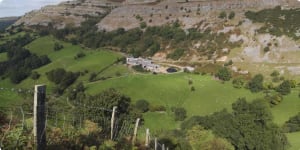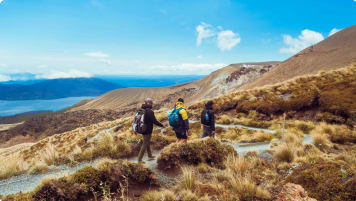Walking Ancient Britain
A walking tour of England & the border of Wales. Explore on foot UNESCO World Heritage sites, Neolithic, Bronze age and Roman landscapes and the occasional Norman castle on your journey. Your tour director and tour guide walk you through the Brecon beacons, the Cotswolds and Welsh borders on this small group tour.
From $13,354CAD
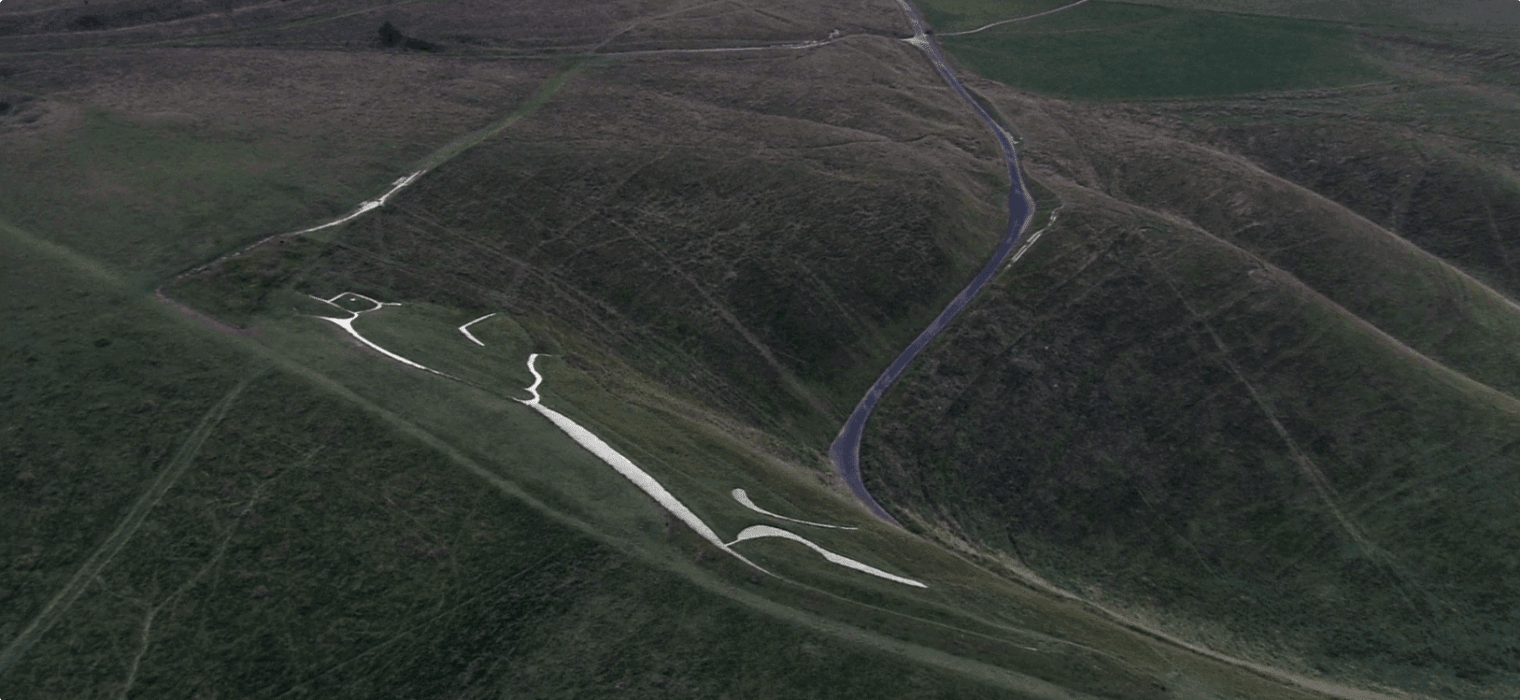
Highlights
- 1. Explore Salisbury Cathedral, one of the finest medieval buildings in Europe and with an elegant spire that was for centuries the tallest man-made structure in England.
- 2. Follow in the footsteps of Britain's Neolithic ancestors at Stonehenge--one of the best known prehistoric monuments in Europe and a British cultural icon.
- 3. View magnificent chalk drawings carved on hillsides. These huge drawings, usually of horses, are unique to this region.
- 4. Walk in the Malvern Hills and enjoy panoramic views of the surrounding countryside while exploring Iron Age hill-top forts and the remnants of Norman castles.
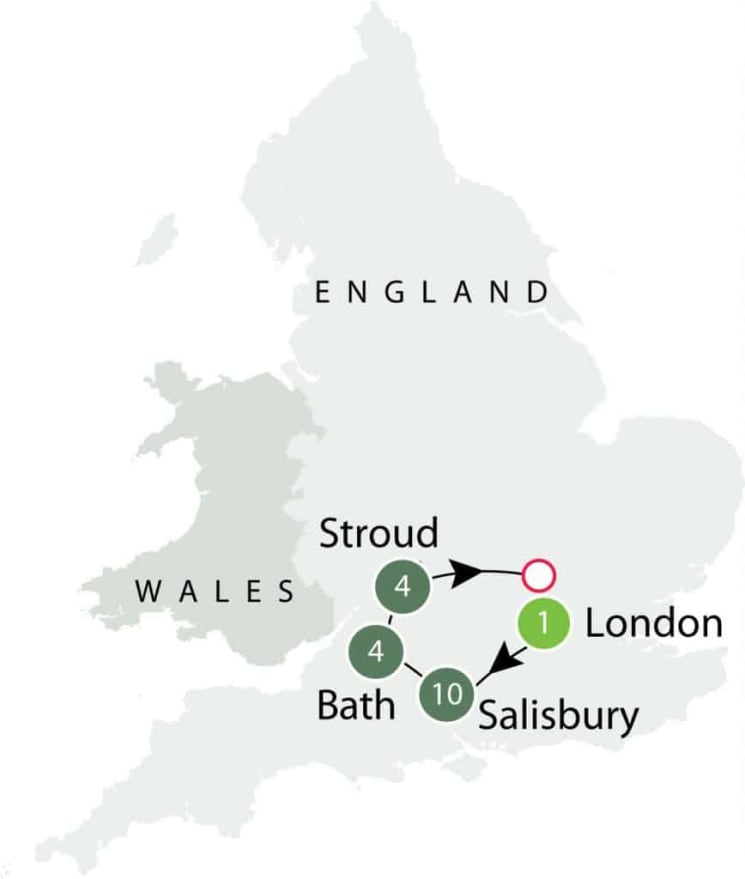
Departure Dates
| Departure Date | Price |
|---|---|
| 08 June 2025 Ends 27 June 2025 • 20 days $13,354 Twin $15,231 Single Available | Selected |
| 07 September 2025 Ends 26 September 2025 • 20 days $13,354 Twin $15,231 Single Available | |
| 07 June 2026 Ends 26 June 2026 • 20 days $13,354 Twin $15,231 Single Available | |
| 06 September 2026 Ends 25 September 2026 • 20 days $13,354 Twin $15,231 Single Available | |
| 06 June 2027 Ends 25 June 2027 • 20 days $13,921 Twin $15,866 Single Available | |
| 05 September 2027 Ends 24 September 2027 • 20 days $14,283 Twin $16,229 Single Available |
Exploring Ancient Britain on foot
Join Odyssey on the Walking Ancient Britain tour, a fully escorted, small-group, 20-day program that will take us through Britain's ancient towns and walkways, hidden gems steeped in over 5,000 years of human history. We will walk through the region surrounding Salisbury, Bath, and Stroud in the southwest of England and along the border with Wales. The tour includes some of the greatest walkways in England. We will typically walk between ten to twelve kilometres to explore these routes and you'll enjoy the beautiful scenery with like-minded people.
Walk on England's Oldest Walkways
This walking tour of ancient Britain will take us through sections of some of the most amazing walking tracks in England:
- Silchester Circular Track
- Great Stones Way
- Ridgeway Track
- Cotswold Way
- Offa’s Dyke Path
- Malvern Hills Track
We will walk along some of the oldest roads in Europe, following in the footsteps of traders, pilgrims, herdsmen, soldiers, and travellers. On this tour, we visit Neolithic hill-top forts, ditches, ramparts and burial sites, Bronze and Iron Age villages markets, houses, and ruins. We will see evidence of Roman occupation and visit Norman castles and cathedrals. On each walk we will uncover more about the thousands of years of human enterprise that this part of England has witnessed.
Explore Ancient Britain's Myths and Legends
The tour will give us the opportunity to explore myths and legends and learn about ancient rituals. We will see where Saint George slayed the mighty dragon and where King Arthur had his legendary round table. We will see one of the oldest maps on Earth. And, above all we will visit Britain’s most famous landmark, the Woodhenge and Stonehenge complex. We will learn that there is more than one explanation for this unique structure.
This walking tour of ancient Britain takes us across rolling hills, beside mighty rivers, through deep valleys, along man-made dykes, through woodlands, around lakes, into magnificent caves and across farmland where sheep and cows graze. The lumps and bumps in the landscape as well as the dry stone walls are all integral to the history.Views are often quite stunning.
Salisbury Cathedral will impress, and so too will the range of abbeys, churches, quaint villages, museums, manor houses, markets, canals, battle sites and natural hot pools. This is also the best part of England to see chalk carvings, often of white horses, on hillsides.
Enjoy a Pleasant Stroll in Autumn
There will be picnics and lunches at cosy pubs. Comfortable hotel rooms to return to, group meals and plenty opportunities to dine out and sample the local cuisine.
The tour is at the end of summer and beginning of autumn. Mornings will be crisp with generally quite pleasant afternoons. The colours of autumn will surround us giving the landscape a special, memorable beauty. Conkers lay scattered about, squirrels gather nuts, birds flutter by and England’s wildlife will be in all its glory. We will enjoy the scrunch of leaves underfoot as we stroll along tracks and through parks dusted with auburn, red, and golden leaves. We will admire early evening sunsets with the sky illuminated by bursts of turquoise and pink.
We will be accompanied throughout the tour by an Odyssey Tour Leader. There will be local guides with specialist knowledge to assist in the presentation of information. We will always have at our disposal a comfortable modern coach with frequent stops.
Walking Ancient Britain tour is offered to the active mature walker in the Autumn as the leaves begin to turn. As a result, this is a holiday program suited to a senior couple or solo travellers who enjoy a good walk. The total number of participants in this tour will be 12 or fewer with the addition of an Odyssey program leader.
Articles published by Odyssey Traveller for Walking and Hiking tours for seniors
To help you prepare for any walking program whether with Odyssey or another company this list of articles is intended to help you prepare for your holiday.
- articles on Selecting walking shoes for women
- article on footwear and walking shoes
- article on what to pack when travelling.
- article on maintaining muscle fitness in senior and mature age travellers
- article on selecting socks for walking
- article detailing six great short walks in Britain
- article on preparing for a walking holiday
- article on Pilgrim walks in Europe
- article on walking in the Lake District
- article on reading the British landscape
Other articles of possible interest is this two-part post filled with travelling tips for seniors, an article on the many nifty gizmos and gadgets you can bring on your trips, and an important article about practising responsible travel.
Articles about Great Britain published by Odyssey Traveller.
The following list of articles published by odyssey Traveller for mature aged and senior travellers to maximise their knowledge and enjoyment of Britain when visiting;
- Roman roads in Britain
- Understanding British Churches
- Medieval British life
- Icons of British villages
- Studying Gargoyles and grotesques
- New discoveries about Britain's stone circles
- Victorian Country life
- Britain's neolithic past
- Lumps and bumps, how to read the British landscape
- The Lake district poets
- English village history
- Britain's National trust
For all the articles published on Britain by Odyssey Traveller, please click through on this link to view.
External articles to assist you on your walk in Britain
- National trust; Britain's best walks with Julia Bradbury
- National Parks of Britain.
- Ten books about Walking in Britain from the Guardian
- UNESCO World Heritage sites of Britain
The following external links should assist you in planning your trip to Great Britain as a tourist and a walker.
- Hiking advice for women
- Aluminium water bottles safe for water?
- Bringing too much luggage and overpacking the day pack.
- Tips for preventing dehydration when walking
Walk with Odyssey Traveller
Walking Ancient Britain is only one of many walking tours offered by Odyssey Traveller. These active tours are designed for the mature traveller to enjoy in a small group holiday and learning environment. Other England tours by Odyssey Traveller may also be of interest.
For more details of this tour, click the ‘Top 5’ or ‘Itinerary’ buttons above! If you’re keen to experience this tour, please call or send an email. Or, to book, simply fill in the form on the right hand side of this page.
Gallery

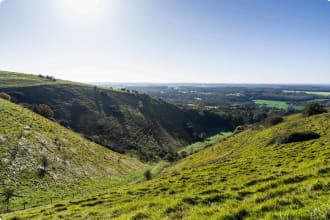
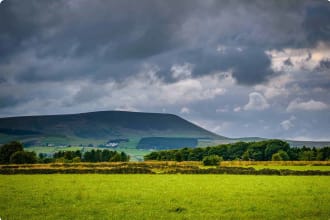

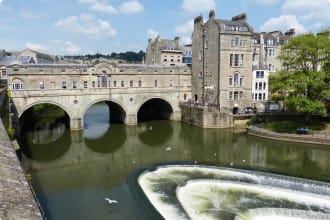
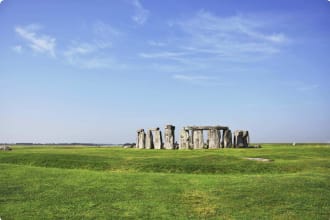
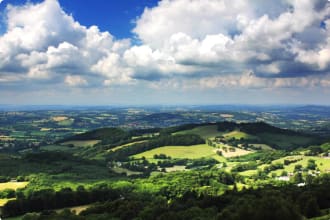
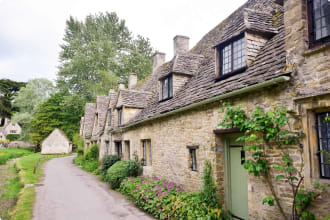
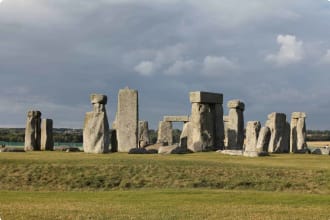
Itinerary
20 days
Day 1: LONDON
Accommodation: Overnight Tower Hotel or similar
We arrive in London and make our way individually to the hotel. We begin our program with an introductory meeting in the late afternoon followed by a welcome dinner.
Day 2: SALISBURY
Accommodation: Best Western Red Lion or similar
Today we transfer to Silchester, a two-hour drive from London. Upon arrival, we enjoy three hours of walking along the historic Silchester circular trail. This area is steeped in history, a witness to an Iron Age settlement, the Roman town of Calleva Atrebatum, and finally a Saxon settlement. We will walk beside a Roman wall, cross open fields and view a 13th century moat with restored fish ponds and water-meadows. Lunch is at a local tavern, most likely the Calleva Arms. Refreshed, we set off again to visit the 12th century St James’s Church and admire its window depicting the murder of Thomas Becket. Following a walk around the remnants of the Roman Amphitheatre, we drive to Salisbury with a stop at Andova Museum. Set in an 18th century Georgian Town house, the museum contains a range of rare Bronze Age relics. We will learn how the ancestors of modern English farmed and fought, and how they worshipped and buried their dead. Dinner is included at the hotel.
Day 3: SALISBURY
Accommodation: Best Western Red Lion or similar
A short drive through picturesque countryside brings us to Dorchester. First stop, Maiden Castle, one of the largest and most complex Iron Age hillforts in Europe – the size of 50 football pitches. During the 1st Century BC, its gleaming white chalk ramparts would have towered over the surrounding landscape and provided safety for its town folk. We learn about the archaeology of this region at a local museum before sitting down to lunch in Poundbury. Prince Charles owns this area, and the experimental town has been designed around his ideas. Has the design really reduced car dependency? Wander about and decide for yourself before we set off for a long walk from Stratton to the medieval village of Cerne Abbas. This walk offers spectacular views of rolling green hills and gives an understanding of the Iron Age banks and ditch system. We will stop and view the famous giant nude male figure carved from a hillside. The evening is free to wander Salisbury and dine at a restaurant of your own choosing.
Day 4: SALISBURY
Accommodation: Best Western Red Lion or similar
Salisbury is a gracious city with a historic centre dominated by “Queen Anne buildings”, an English Baroque style of architecture. During the morning we will stroll through the streets with our local guide. England is endowed with countless stunning churches but nothing compares with the grandeur and sheer spectacle of 13th century Salisbury Cathedral. The 123-metre spire is England’s highest. We will stand in awe of the elaborate Gothic-style exterior, set our watches from the 1386 clock and enter the somewhat austere interior. One of the four original copies of the Magna Carta is displayed here. The afternoon is free for you to enjoy Salisbury’s other attractions and dine on your favourite cuisine.
Day 5: SALISBURY
Accommodation: Best Western Red Lion or similar
Today we drive a short distance to Great Durnford and set off on the longest walk of the program – 13 kilometres return to Salisbury. Chalk grassland is firm underfoot and there are plenty of distractions on this heritage trail, which links Saxon earthworks, Norman churches, thatched cottage hamlets, cosy pubs and historic villages, while at times meandering alongside the River Avon. We have time to explore the 12th century church of St Andrew in the village of Great Durnford. Following a picnic lunch, we climb the mighty ramparts of Old Sarum for views over the Wiltshire plains, stand in the footprint of Salisbury’s original cathedral, explore the remnants of a Neolithic settlement of hunters and farmers, wander a Norman castle and unearth 5,000 years of history. Dinner tonight is by own arrangements.
Day 6: SALISBURY
Accommodation: Best Western Red Lion or similar
An archaeologist joins us today to enhance our knowledge of the magnificent Stonehenge complex. We begin with a visit to Woodhenge, an atmospheric Neolithic site probably constructed about 2300 BC. Here we will see the remnants of a large burial mound, surrounded by a bank and ditch. Today concrete markers replace the six concentric rings of timber posts which it is believed once supported a ring-shaped building. We also spend time exploring the Durrington Walls which gave sanctuary to up to 4,000 people. We walk along Stonehenge Avenue and Stonehenge Cursus, a long and wide series of parallel banks and ditches that once formed a processional route. Our day concludes at Stonehenge, one of the most famous landmarks in Britain. Our guide will explain the significance and meaning of this ring of standing stones soaring 4 metres high, 2 metres wide and weighing up to 25 tons. There will be no attempt to define a single use for Stonehenge, whose function changed over time. Dinner is by own arrangements from the wide variety of restaurants available in Salisbury.
Day 7: SALISBURY
Accommodation: Best Western Red Lion or similar
A short drive brings us to Netheravon, an historic village with an 11th century church, an 18th century manor house and a cavalry school, set on the banks of the Avon River. We then walk 8.5 kilometres across grasslands, farms and beside artificial lakes to Casterley Camp, a hilltop fortress steeped in Iron Age, Roman, and Anglo-Saxon history. Along the way we see a variety of well-preserved chalk archaeological remnants. After lunch we drive to Winchester and enjoy a guided city walk which includes the cathedral, one of the largest in Europe and with the longest nave and overall length of all Gothic cathedrals. Jane Austen is buried here near the oldest choir stalls in England.
Within the Winchester Cathedral Close are a number of historic buildings spanning the 11th to the 16th centuries plus considerable evidence of when this was once a site for pilgrims. Winchester is also home to the University of Winchester and Winchester College, the oldest public school in the United Kingdom still using its original buildings. There was once a significant Jewish population here and present-day Jewry Street offers evidence. Winchester is also well known for the 12th century Great Hall of its castle. King Arthur’s Round Table has dominated the hall since 1463. It isn’t the original, but still attracts enormous interest from visitors. Our tour will include an almshouse where a ‘wayfarer’s dole’ of ale and bread has been handed out since the 14th century. It was supposedly instigated to aid pilgrims on their way to Canterbury. Dinner is by own arrangements upon our return to Salisbury.
Day 8: SALISBURY
Accommodation: Best Western Red Lion or similar
We return to the Great Stones Way walk and complete another section, this time 12 kilometres from Casterley Camp to Honeystreet. We walk along one of the oldest roads in Europe, following in the footsteps of traders, pilgrims and travellers from long ago, to enjoy stunning views of the countryside made famous in recent times by unusual crop circles. From the village of Alton we admire a chalk hill figure of a horse dating from 1812, and from a hilltop near the village of Pewsey another white horse, created in 1937 to replace an earlier one. Pewsey was once owned by the Saxon King Alfred and today his statue dominates the village centre. We also have time to explore Honeystreet village notable for its Barge Inn, built to cater for those living and working on the canal. Our tour concludes with a short drive to 13th century Lacock village with its quaint traditional stone cottages, old workhouse, medieval barn, prison and church. The central grid of four streets gives Lacock a centuries-old appearance. We visit Lacock’s oldest house, with its mish-mash of different architectural styles and Lacock Abbey, a nunnery from 13th to 16th centuries but later converted into a residence. Fortified and loyal to the Crown during the English Civil War, the abbey eventually surrendered to Parliamentary forces in 1645. Dinner is by own arrangements upon our return to Salisbury.
Day 9: SALISBURY
Accommodation: Best Western Red Lion or similar
Today we enjoy another walk along the Great Stone Way beginning at Knapp Hill and continuing ten kilometres to Avebury. We view a wonderfully sited Neolithic burial mound atop a hill at Adam’s Grave and enjoy breathtaking views across the Vale of Pewsey. The ascent up to The Wansdyke is steady with wide sweeping views back to Avebury and Silbury Hill. We descend into West Kennet Long Barrow, a burial chamber that pre-dates Stonehenge, then cross the River Kennet and walk the West Kennet stone avenue. Set between two parallel lines of stones, the ‘avenue’ is 25 metres wide and 2.5 kilometres in length. A short drive takes us to Devizes, a market town that developed around the Norman Devizes Castle in the 12th century. From the 16th century Devizes became known for its textiles and later brewing and the manufacture of snuff. Devizes was once a coaching stop and boasts more than 500 historically listed buildings with an architectural heritage. Time is set aside to wander and enjoy. There is a great sense of community here and the town hosts many festivals. Our tour ends at Wiltshire Museum to view gold and amber memorabilia from the time of Stonehenge. Wiltshire Museum lays claim to the best Bronze Age archaeological collection in Britain. The Wiltshire Galleries tell the story of the people who built and used the monuments of Stonehenge and Avebury. We return to Salisbury with another night to enjoy the gastronomical delights of the city.
Day 10: SALISBURY
Accommodation: Best Western Red Lion or similar
Avebury is an excellent place to go to get a real close-up look at ancient Neolithic stone circles and henges. You can even give them a hug if you wish! After a short drive, we arrive at Avebury Village with time to explore its lovely old buildings, then we set off on a 12-kilometre walk to Barbury. We pass through one of the country’s oldest Natural Nature Reserves, Fyfield Down, (created in 1955). The reserve offers pre-historic ruins and a wide range of birds and wildflowers. Our walk ends at Barbury Castle, a site first occupied 2,500 years ago. Here we will explore two deep defensive ditches and ramparts. A short drive brings us to Highclere Castle to view its great hall, dining room, library, music room, drawing room, saloon and bedrooms. There is time to explore the 2,000 hectare grounds and Egyptian exhibition. Highclere Castle was associated with the 5th earl of Carnarvon, patron of the Egyptological expedition that discovered and opened the tomb of the pharaoh Tutankhaman in 1922. As an outcome, the earl’s collection is on display in the castle. Upon our return to Salisbury, we dine by our own arrangements at a restaurant.
Day 11: SALISBURY
Accommodation: Best Western Red Lion or similar
A short drive brings us to the town of Idstone to commence a different walking track, the Ridgeway. Today we follow a route used for over 5,000 years by travellers, traders, herdsmen, drovers, and soldiers. We pass through chalk downland, secluded valleys and scattered woodlands of beech, yew, and juniper. Along the way we visit Wayland’s Smithy, a Neolithic chambered barrow which once contained a wooden mortuary house. Today a paved stone floor with two large posts at either end is all that remains. Postholes indicate that it once supported a timber façade. Before enjoying a picnic lunch we view the famous Uffington White Horse, a highly stylised prehistoric hill side figure formed by deep trenches filled with crushed white chalk. This is the oldest white horse figure in Britain. A short distance away was born the legend of Saint George slaying the dragon. We will mount Dragon Hill, a natural chalk hill with an artificial flat-top and view a bare patch of chalk upon which no grass will grow and purported to be where the dragon’s blood spilled. The nearby Blowing Stone will also attract our attention. This perforated stone is capable of producing a booming sound if someone with the required skill blows into one of its holes the right way. According to legend King Arthur summoned his troops this way. Our walk concludes at the village of Kingston Lisle with time to relax in its park and admire the 17th century country house. Dinner is by own arrangements upon our return to Salisbury.
Day 12: BATH
Accommodation: Harington’s Hotel or similar
We check out of our Salisbury hotel and drive to Warminster, a town situated beneath chalk downland and boasting many historic attractions such as Warminster Maltings (Britain’s oldest maltings, or beer brewing site) and Dents glove factory, founded in 1777, and still supplying gloves for royalty. We walk 11 kilometres to Knook. Our first stop is Battlesbury Fort. Occupying a summit, this 2,000 year old fort has defences follow the natural contours of a hill and triple ditches and ramparts. We also visit Scratchbury Fort, set on a steeply contoured hill, the fort offered natural defences in all directions. Inner earthworks are typical of a “quarry-ditch” formation, whereby the material excavated from the inner ditch was used to create the rampart. The site occupies the summit of Cotley Hill where we also explore a flint quarry. Our walk continues past burial mounds at Middle Hill and patches of woodland to Knook. Centuries of grazing sheep have led to considerable erosion with soil creep and sheep paths clearly visible. We transfer to Bath with dinner included at the hotel.
Day 13: BATH
Accommodation: Harington’s Hotel or similar
Today is a free day to explore Bath. Your Program Leader will offer ideas on how to use the day productively. Known for its restorative wonders and as the home of Jane Austen, you will find plenty to admire in this open-air museum. Maybe there will be time to soak in the natural hot waters!
Day 14: BATH
Accommodation: Harington’s Hotel or similar
A short drive brings us to Wells, England’s smallest city. Once a Roman settlement, Wells has been an important ecclesiastical centre since the 8th century. We visit the magnificent walled precinct to view the cathedral which is surrounded by one of the largest cathedral closes in England. The complex was built in stages over several centuries and showcases many Gothic styles. Several notable features adorn the cathedral such as the scissor arches that support the central tower plus over 300 medieval statues. We won’t miss the famous clock with its 24 hour astronomical dial and set of jousting knights that perform every quarter-hour. The cathedral also boasts the heaviest ring of ten bells in the world. The Vicars’ Close is the oldest residential street in Europe and the grand Bishop’s Palace has been the official residence of the Bishop of Bath and Wells since the 12th century. The Church of St Cuthbert is also on our agenda. Medieval buildings and cobbled streets radiate out from the cathedral green to a marketplace that has been the bustling heart of the city for nine centuries.
Our next stop is Glastonbury to visit its famous Abbey. Founded in the 7th century it was one of the richest and most powerful monasteries in England. Our tour includes the 10th century church, the Abbot’s Kitchen, one of the best preserved medieval kitchens in Europe and the library with its collection of ancient manuscripts. From the 12th century, Glastonbury has been associated with the legend of King Arthur and his grave is purported to lie in the nearby cemetery. We will watch out for modern-day pilgrims.
Our tour concludes with a visit to Glastonbury Tor, a conical terraced hill topped by a 14th century church tower. Rich in legends and mythology the Tor was a place of ancient ritual and pilgrimage and a place that merged Christian and pagan beliefs. We enjoy the sweeping views of Somerset countryside and try to imagine how this area was once sea and the Tor an island accessible by boat. We return to Bath via Cheddar Gorge and view some of the caves with their stalactites and stalagmites. It was here Britain’s oldest complete skeleton was discovered. These caves gave their name to cheddar cheese, as the caves were used during pre-historic times for maturing cheese. Dinner is by own arrangements upon return to Bath.
Day 15: BATH
Accommodation: Harington’s Hotel or similar
Today we drive to Castle Combe, a small village dubbed “the prettiest in England’. Three narrow streets converge at market cross. The town originally grew up beneath a Norman castle, the ruins of which lie in the hills above. During the Middle Ages, the valley and village prospered due to the wool industry. The spinners and weavers lived in typical Cotswold type cottages, constructed in stone with thick walls and roofs, while the By Brook River provided power to run the mills. We have time to explore the village, its churches and market streets before transferring to Cold Aston to begin a 10-kilometre walk along a section of the 164-kilometre-long Cotswold Way.
There is much to keep us interested. At Lansdown battlefield we see where in 1643 a decisive battle of the English civil war took place. The battle was a nominal Royalist victory but was not decisive enough to settle the fate of South West England. The site of the battle is marked by a monument to a Royalist commander. Nearby is the Bath Racecourse, established in 1811 and racing thoroughbreds ever since. Today we see evidence of 5,000 years of economic activities carried out including: flint knapping, brass hammering, sheep raising, dairy herds, horse racing, and leisure boating, with holiday cottages dotting the landscape. Our walk follows the fascinating story of human enterprise.
We also pass Kelston Round Hill fort, a steep climb, and view Bath Golf Club, created in 1880 and one of England’s finest and oldest. Our walk ends in Bath at the Royal Crescent, a row of thirty terraced houses laid out in the 1770s in a sweeping crescent and supported by 114 Ionic columns. This is one of the finest examples of Georgian architecture. During the Blitz, numbers 2 and 17 were gutted by incendiaries.
Dinner is by own arrangements at one of Bath’s many delightful restaurants.
Day 16: STROUD
Accommodation: The Imperial Hotel or similar
We check out of our hotel and drive one hour to Chepstow on the Welsh side of the border. Chepstow Castle overlooks the town and River Wye. The 11th century Great Tower is the oldest part of the castle. Much of Chepstow’s 13th century Port Wall remains intact and protects a Benedictine priory established in 1067. Parts of it remain intact. This is a town noted for its historic imports of wine and exports of timber and bark. From Chepstow, we begin a 9-kilometre walk along the Offa’s Dyke Path to Tintern through changing landscapes, offering opportunities to catch a view of native wildlife. At times we follow the Offa Dyke, 20 metres wide and 2.4 metres high, a large earthwork that roughly follows the border between England and Wales. Devil’s Pulpit, a flat plateau, offers us a scenic viewpoint across the River Wye to Tintern Abbey. Legend holds that from here the devil would taunt monks at the abbey below. Founded in 1131, the abbey fell into ruin after the dissolution of the monasteries in the 16th century. What we see are a mixture of buildings covering a 400-year period. The main attraction here are the remnants of the highly decorated Gothic church.
We continue our day with a drive through the Wye Valley, an area of outstanding natural beauty and one of the most scenic landscapes in Britain. This is where British tourism began in the 18th century. We stop at Hereford for a guided walking tour of this historic city. Our tour includes the Old House, a museum showing life in the Jacobean era of the 1600s and the Cider museum with its interactive guide to producing the drink. Hereford Cathedral was originally established in the 7th century but destroyed. The current building dates from 1079 and houses ten bells high in its tower. The choir, consisting of three Norman bays, the Bishop’s throne and the figures of angels deserve our attention. What we see is a restored cathedral built after the 1786 collapse of the west tower. Here we will see the world-famous Mappa Mundi, the largest medieval map known to exist. Drawn during the 13th century, Jerusalem is at the centre, east shows the Garden of Eden. England is at the north-west border. The map depicts 420 towns, 15 Biblical events, 33 animals and plants, 32 people, and five scenes from classical mythology. It does not imply a flat Earth.
Our program ends at Stroud, a town noted for its steep streets, independent spirit and cafe culture. This was a cloth town with woollen mills powered by small rivers. From Stroud stretches a canal network. This town boasts a significant artistic community, is one of the birthplaces of organic foods and regularly hosts a fringe festival. Tonight we dine as a group.
Day 17: STROUD
Accommodation: The Imperial Hotel or similar
The focus today will be the Offa’s Dyke Path that roughly follows the current border between England and Wales. A two-hour drive brings us to the Offa’s Dyke Information Centre at Knighton. Here we will learn about the 8th century 283-kilometre-long earthwork structure built by Offa, the King of Mercia (one of the small kingdoms that pre-dated a unified England). The dyke is believed to be defensive with a ditch on the Welsh side and displaced soil on the English side. We learn about the huge workforce and vast resources required to construct the dyke using only hand tools and how the embankments were possibly crowned by a wooden palisade. There will be time to admire Knighton’s old clock tower before we transfer to Pilleth, a small village that was once a place of pilgrimage due to the reputed healing powers of its holy well. We visit the church, the current structure dating mainly from the 13th century, the tower from the 14th and the bell the 15th.
Pilleth is also the site of the Battle of Bryn Glas (or battle of Pilleth) 1402. This was a great victory for Welsh rebels under Owain Glyndwr who declared himself the true Prince of Wales. An English army of over 4,000 men was defeated and today a tiny church that predates the battle and a strand of Wellingtonia trees commemorate the site of the battle. Our walk today is 12 kilometres through stunning landscape from Discoed to Kington. We see some of the best preserved sections of the dyke, make two steep climbs for the view and pass Kington golf course which, at 340 metres above sea level, is the highest in England. Curiously, the course provides wooden shelter for protection from unfavourable weather. Kington is an historic market town situated in the valley of the River Arrow and on the English side of the Welsh/English border. We return to Stroud and dinner is by our own arrangements.
Day 18: STROUD
Accommodation: The Imperial Hotel or similar
This is one of our best days for views. A short drive brings us to Little Malvern, a village with a Romanesque-style church and historic house occupied by the same family for four centuries. Our 11-kilometre walk takes us through the spectacular Malvern Hills, a range that dominates the surrounding countryside, towns and villages and known for its healthy spring water. Our walk offers us stunning views and we will scale several vantage points. Herefordshire Beacon, at 338 metres, not only offers views but also provides the opportunity to explore an Iron Age hill fort known as the British Camp which was violently destroyed around 48 AD. The summit subsequently became a Norman castle. Medieval castles frequently built within an earlier site, reusing the earthworks of older establishments. Human settlement can be traced back to 2nd century BC here.
From Millennium Hill and Hangman’s Hill we also enjoy spectacular vistas. Midsummer Hill is about two kilometres from British Camp. It is unusual to have two major hill forts within such a short distance and it too was destroyed violently. Midsummer Hill Fort is very unusual in that the ramparts enclose two hills and the intervening valley. It is worth noting that Tolkien found inspiration to write The Lord of The Rings following a visit to the mist-clad Malvern Hills. Built around 390 BC, it is thought the settlement was occupied by 1500 people. Our walk concludes at Hollybush and we return to Stroud for dinner by our own arrangements.
Day 19: STROUD
Accommodation: The Imperial Hotel or similar
A short drive brings us to Nympsfield, a village on the path of the former Roman Road. Nympsfield is the site of Woodchester Mansion, an unfinished Gothic mansion. From here we begin a 12-kilometre walk along part of the Cotswold Way. We visit the Neolithic Nympsfield long barrow, probably built around 3000 BC. We explore the central passage and its three burial chambers. The barrow has been excavated and 23 bodies and the remains of cremated children have been discovered. We also visit Hetty Pegler’s Tump long barrow where digs have uncovered the remains of fire, pig bones, and evidence of ritualised meals.
Our tour includes Uley Bury, set on a long flat-topped hill. This scarp-edge Iron Age fort dating from 300 BC overlooks the Severn Vale. The fort was created by terracing a double line of ramparts about two kilometres in length into the hillsides. Our walk concludes at Owlpen Manor house which dates from the 13th century but was largely rebuilt during the Tudor period. The manor contains several rare painted cloth wall-hangings. We spend some time enjoying the hanging terraced gardens with its yew topiary delights. This is one of the earliest continuously cultivated domestic gardens in England. Upon our return to Stroud we celebrate with a farewell dinner at the hotel.
Day 20: LONDON
Our tour concludes with a journey to London Heathrow Airport or at breakfast if you have decided to stay on.
Tour Notes
- A high level of fitness is required for this tour.
Includes / Excludes
What’s included in our tour:
- 19 nights of hotel accommodation
- 19 breakfasts, 2 picnic lunches and 5 dinners
- All excursions, entrance fees and tipping as per itinerary
- Transport in comfortable and modern coaches
- Services of Tour Leader for the duration of tour
- Local guides at specific destinations
- Detailed preparatory material
What’s not included in our tour:
- International airfares and departure taxes
- Comprehensive travel insurance
- Items of a personal nature such as telephone calls, laundry and meals not listed on the itinerary
Participants must be in excellent health, extremely mobile and live an active lifestyle. Program activities may include up to 6 hours of continuous strenuous, moderate-to-fast paced activities per day on varied terrain.
Book now
Make it a private tour
Easing your journey
Crossing international borders with restrictions
The list of requirements to travel internationally has changed and will continue to change for several years. Odyssey is here to assist you in managing your way through these requirements:
For more information see our Crossing international borders with restrictions page.
Book With Confidence
If less than 30 days before your tour starts you are unable to travel as a result of Government travel restrictions, Odyssey Traveller will assist you with a date change, provide you with a credit or process a refund for your booking less any non-recoverable costs.
See Terms and conditions for details.
Peace of Mind Travel
The safety of our travellers, tour leader, local guide and support staff has always been our top priority and with the new guidelines for public health and safety for keeping safe for destinations around the world, we’ve developed our plan to give you peace of mind when travelling with us.
See Peace of Mind Travel for details.
Reading List Download PDF
Prehistoric Britain (Routledge World Archaeology) 2010
Timothy Darvill
Britain has been inhabited by humans for over half a million years, during which time there were a great many changes in lifestyles and in the surrounding landscape. This book, now in its second edition, examines the development of human societies in Britain from earliest times to the Roman conquest of AD 43, as revealed by archaeological evidence. Special attention is given to six themes which are traced through prehistory: subsistence, technology, ritual, trade, society, and population.
Prehistoric Britain begins by introducing the background to prehistoric studies in Britain, presenting it in terms of the development of interest in the subject and the changes wrought by new techniques such as radiocarbon dating, and new theories, such as the emphasis on social archaeology. The central sections trace the development of society from the hunter-gatherer groups of the last Ice Age, through the adoption of farming, the introduction of metalworking, and on to the rise of highly organized societies living on the fringes of the mighty Roman Empire in the 1st century AD. Throughout, emphasis is given to documenting and explaining changes within these prehistoric communities, and to exploring the regional variations found in Britain. In this way the wealth of evidence that can be seen in the countryside and in our museums is placed firmly in its proper context. It concludes with a review of the effects of prehistoric communities on life today.
With over 120 illustrations, this is a unique review of Britain's ancient past as revealed by modern archaeology. The revisions and updates to Prehistoric Britain ensure that this will continue to be the most comprehensive and authoritative account of British prehistory for those students and interested readers studying the subject.
Britain BC: Life in Britain and Ireland Before the Romans
Francis Pryor
An authoritative and radical rethinking of the history of Ancient Britain and Ancient Ireland, based on remarkable new archaeological finds.
British history is traditionally regarded as having started with the Roman Conquest. But this is to ignore half a million years of prehistory that still exert a profound influence. Here Francis Pryor examines the great ceremonial landscapes of Ancient Britain and Ireland – Stonehenge, Seahenge, Avebury and the Bend of the Boyne – as well as the discarded artefacts of day-to-day life, to create an astonishing portrait of our ancestors.
This major re-revaluation of pre-Roman Britain, made possible in part by aerial photography and coastal erosion, reveals a much more sophisticated life in Ancient Britain and Ireland than has previously been supposed.
This edition does not include illustrations.
Iron Age Britain
Barry Cunliffe
This revised introduction to Britain in the first millennium BC incorporates modifications to a story that is still controversial. It covers a time of dramatic change in Europe, dominated by the emergence of Rome as a megastate. In Britain, on the extremity of these developments, it was a period of profound social and economic change, which saw the end of the prehistoric cycle of the Neolithic and bronze Ages, and the beginning of a world that was to change little in its essentials until the great voyages of colonization and trade of the 16th century. The theme of the book is that of social change within an insular society sitting on the periphery of a world in revolution.
Ancient Wonderings: Journeys Into Prehistoric Britain
James Canton
Take a journey into our ancient past. Explore a long-lost landscape and gradually discover the minds, beliefs and cultural practices of those souls who lived on these lands thousands of years before you.
Travelling the length and breadth of Britain, James Canton pursues his obsession with the physical traces of the ancient world: stone circles, flint arrowheads, sacred stones, gold, and a lost Roman road. He ponders the features of the natural world that occupied ancient minds: the night sky, shooting stars, the rising and setting sun. Wandering to the furthest reaches of the islands, he finds an undeciphered standing stone north of Aberdeen and follows the first footsteps on the edge of a long-lost Ice Age land in the North Sea.
A History of Ancient Britain
Neil Oliver
Continues Neil Oliver's landmark exploration of how our land and its people came to be, which began with the acclaimed A History of Scotland.
The Last Wolf: The Hidden Springs of Englishness
Robert Winder
What sort of a place is England? And who are the English? As the United Kingdom turns away from its European neighbours, and begins to look increasingly disunited at home, it is becoming necessary to ask what England has that is singular and its own.
It is often assumed that the national identity must be a matter of values and ideas. But in Robert Winder's brilliantly-written account it is a land built on a lucky set of natural ingredients: the island setting that made it maritime; the rain that fed the grass that nourished the sheep that provided the wool, and the wheat fields that provided its cakes and ale. Then came the seams of iron and coal that made it an industrial giant.
In Bloody Foreigners Robert Winder told the rich story of immigration to Britain. Now, in The Last Wolf, he spins an English tale. Travelling the country, he looks for its hidden springs not in royal pageantry or politics, but in landscape and history.
Medieval monks with their flocks of sheep . . . cathedrals built by wool . . . the first shipment of coal to leave Newcastle . . . marital contests on a village green . . . mock-Tudor supermarkets - the story is studded with these and other English things.
And it starts by looking at a very important thing England did not have: wolves.
